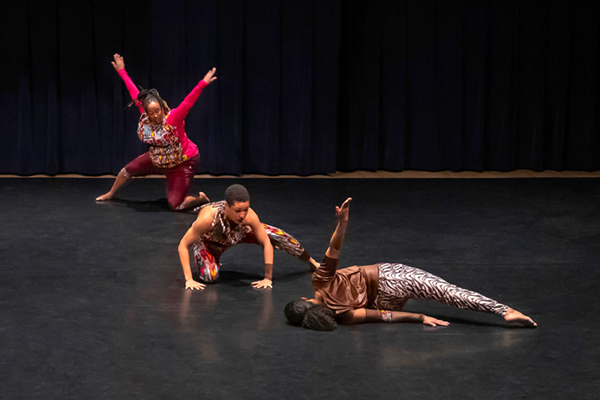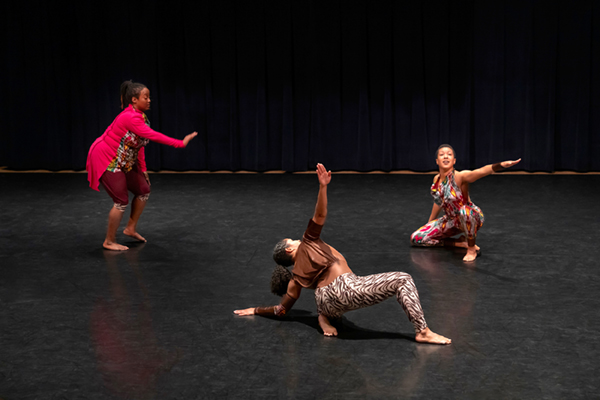Conjuring Imagination Through Movement
An Interview with Maria Bauman-Morales
BY EMMALY WIEDERHOLT
Maria Bauman-Morales is a New York City based choreographer and the artistic director of MBDance, as well as a two-time resident through the CUNY Dance Initiative, which offers available space through the CUNY university system to NYC dance artists. MBDance centers the non-linear and linear stories and bodies of queer people of color using dance as the wheel from which multiple other genres including visual art, text, and song are spokes. Here, she details her involvement in the CUNY Dance Initiative as well as how her choreography is an extension of her work as a community organizer.
MBDance in Up and Down Her Back, Photo by Liz Schneider Cohen
~~
What has been your involvement with the CUNY Dance Initiative (CDI) and how has it shaped your practice?
I was one of the inaugural recipients the first year of CDI. My company, MBDance, was in residence at Brooklyn College, and then we did it again the next year, so we actually had two residencies back to back. I’m sure people are well aware of the deficit of spaces for dance in NYC; there are so many people here doing amazing work, and a lot less space than there are people. At that time, my company was working on a piece called Attend Me. I was researching Audre Lorde, as well as the concept of love between Black women: sister love, mother-daughter love, sister-friend love, and romantic love. Just having the time and a regular space to investigate what we were reading, and then to embody it and expand on it, was incredibly helpful. We eventually took that piece to Los Angeles in addition to performing it in NYC.
During both of our residencies through CDI, we hosted open rehearsals. We had conversations on the themes in the piece, centering Black women and this amazing lesbian artist, Audre Lorde. That created really rich discussion. I had also initiated research groups. Folks were tasked with reading different pieces of literature and then sharing their research, so those folks came to Brooklyn College to be a part of the open sessions. We also had a Radical Love Fest – a facilitated experience where folks got to delve into the themes that fed into the artistic process through research instead of performance.
Certainly, having the CDI residency raised the profile of MBDance, which was much appreciated. This was a general plus in addition to the nuts and bolts of having space and time, which was the most wonderful aspect.
Can you share a little about Up and Down Her Back, the piece you will be presenting at the CUNY Dance Initiative’s 5th Year Fest?
Up and Down Her Back comes from a line in the children’s handclap game “Miss Mary Mack,” which I believe is more than a game; it’s a conjuring into adulthood. Children chant and sing on the playground about things they don’t really know about. Up and Down Her Back is a trio I dance in along with two phenoms: Kayla Hamilton and Courtney Cook. In the piece, we’re going back into that conjure space of childhood and seeing what conjure space we still inhabit as adult Black women. We speak and dance at the same time, and there’s also a sound score. Our speaking is a mixture of true and untrue tales.
I’ve been studying children’s games as a way of firming up and toning our imaginations. These are not my favorite times we’re living in politically. There’s a lot to be desired. When I think about desiring and acting on desires, I’m left with imagination. What can we imagine that’s new and different? This isn’t a political work per se, but it does come from that line of inquiry around how we can imagine ourselves into something better. It’s not a statement, but we are trying to practice imagining ourselves into a different future. We’re coming at that through these childhood games that little girls play.
How would you describe your choreography to someone unfamiliar with it?
I would say it is athletic and informed by my long study, practice and love of Capoeira, the African-Brazilian martial art. You can see that exemplified in the low, wide horizontal movements I choreograph. The dancing is intimate and hot. I don’t use the word “hot” to mean sexual or even virtuosic, but rather that it is personal and attached, as opposed to cool and detached.
What does your choreographic process look like?
I think of the choreographic process as a life teacher. We all have themes in our lives that we are wrestling with, researching or investigating. As those themes come to me, I become a bit of a scientist – making hypotheses, testing things out, imagining things from a different perspective. That gets me into my body; I start from an embodied place. I say that the choreographic process is a life teacher for me because I don’t separate too much what I’m investigating inside the studio from what I’m investigating outside the studio in the rest of my life. The dance studio is a practice lab for new philosophies I’m trying to hone or ways of being I want in my life. I’m lucky to work with company members who approach artistic work the same way.
Are there certain themes or issues that feel important to you to keep tackling or addressing in your work?
I literally was working in the studio last night, and two of us looked at each other and said, “dying and dying and dying just keeps coming back.” dying and dying and dying is a piece that I created and premiered in 2017. Some of those themes, which seem to be recurring, are around ancestors and what we can know from the folks who came before us. Another theme that comes up in my work is interdependence: What can we gain and learn from being tethered to other people? A final theme is resourcefulness: How can we rely on ourselves and each other to make something larger than what we thought we had? Whether that’s using improvisation, speaking, physical partnering, making installations out of found objects – resourcefulness comes up in a lot of different ways.
An important component of your work is as a cultural organizer and activist. How does your choreographic practice influence your community practice, and vice versa?
Some of the same ideas of being an artist come up as a community organizer. For example: developing leadership among the group, learning from history, and recognizing how race and racism are playing out in a room at any given time. Those are lessons, questions and philosophies I’m constantly working to embody in the rehearsal studio and onstage as well. I’m cofounder along with two other Black artists – Nathan Trice and Sarita Covington – of a humanistic anti-racist community organizing group called ACRE. ACRE stands for Artistic Co-creating Real Equity. I find that the way I move with ACRE is similar to the way I move in the rehearsal studio. I try to figure out what’s the pulse, or the heartbeat, that everyone in the room can be passionate about and bring their full selves to, as opposed to using people as a means or tools for my vision. That is one way to work, but I think my community organizing mindset wouldn’t allow me to do that. As a result, my creative process is richer. It actually makes me hone in on my creativity and be more imaginative by asking, “What is my dancer saying? What is her way into this theme? Is it different than mine? What does that mean about the different experiences in the world around all kinds of markers of identity?” That perspective makes me a stronger artist.
Why is the CUNY Dance Initiative important for a healthy dance ecosystem?
I love your use of the word “ecosystem.” I do feel like CDI is helping to fertilizer our ecosystem and help us proliferate. One of the ways I see that is small companies and beginning dance companies being supported as much or more than the larger organizations. I want to be clear that we need those larger organizations with a long history to have support – it’s not either/or – but when we think about an ecosystem, we need all the generations to be healthy. One of the things CDI does well is to help nourish some of the younger choreographers as well as the more experienced ones.
I also think it’s really helpful to be able to work with community members in the places we have residencies. Though it’s not a mandate of CDI, when it does work for both the college and the artist in residence, interfacing with the community allows for richness. It’s a real plus of CDI, in addition to the fundamentals of accessing space. The economy around dance spaces is in high relief, so to offer a dance company space to come back to regularly, and then to free up that money that would have gone for paying for space to instead pay dancers more or pay for a special workshop, whatever that is, a little freed up funding goes a long way.
Any other thoughts?
Up and Down Her Back is a small part of a larger work called Desire: Sankofa Dream. I’m able to create this through another residency at Brooklyn Arts Exchange. These kinds of residencies are really impactful for choreographers and dance companies. It’s not surprising that many of us are making work through these initiatives.
MBDance in Up and Down Her Back, Photo by Liz Schneider Cohen
~~
To learn more about Maria’s work, visit www.mbdance.net, and to learn more about the CUNY Dance Initiative, visit www1.cuny.edu/sites/dance-initiative.


